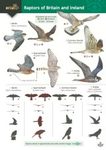By
Keith
4 Aug 2023
Written for Hardback
Mike Pienkowski has been involved in bird conservation for over 50 years, and in 1984 he became the Head of Ornithology at the Nature Conservancy Council. As such he was at the centre of efforts to bring back the Red Kite
Milvus milvus to the UK and he chaired the joint NCC/RSPB project team from 1987 to 1995.
The story of the reintroduction of Red Kites has been summarised in several other places but particularly in several papers by Ian Evans and in
The Red Kite by Ian Carter (Arlequin Press, 2001). However, this new account goes into immense detail, indeed at times probably too much detail for some readers. What the author does is lay the ground for how any kind of reintroduction should be evaluated. By including copies of some of the preparatory documents that were put together, and referring to other reintroductions he shows how the pros and cons must be considered.
A very useful chapter summarises the past and current Red Kite population levels in each of the countries within its range. A decision was needed on where any chicks could be sourced. Spain and Sweden were the eventual main favourites although a small number of birds were sourced from Wales. There is also a lot of detail about how the initial and subsequent release sites were chosen, and the various challenges that were presented from within the Government but also some notable landowners.
The collection and release of the young Red Kites are described across two chapters, with plenty of fascinating insight backed up with photographs taken at the time. I particularly found this section of the book interesting, especially the initial results from the releases in England and Scotland. For example, in the initial English release in 1989 only male chicks had been sourced, and so it was only in 1991 that viable pairs were formed, followed by the first nesting in 1992. The growth since then has been amazing, and where I study Red Kites in Hampshire I estimate there are now around 500 pairs. For example, on an 80-hectare farm, I know of three regular nesting pairs. The author mentions the 2020 UK population to be at 1800 pairs. That has to be an error, as the most recent data suggested 4400 pairs in 2016, and my local population has probably doubled since then.
The section on education and public awareness was interesting, as many of us now see Red Kites every week – if not every day. The chapter on operational delivery reveals the challenges of working for a Government agency that is under attack and the author’s frustrations are clear. This lengthy passage makes quite hard reading, including a fair amount of politics, but also details of the actual results – the latter being of greater interest, so would have benefited from a tighter edit. A final section looks at the outcomes but then merges with thoughts on other possible releases for species including White Storks
Ciconia ciconia, Pine Marten
Martes martes and Eurasian Lynx
Lynx lynx … another opportunity for some editing.
To have Mike Pienkowski’s personal account of how everything happened provides not only a unique insight into the world of reintroduction but also how government agencies approach such projects. For those who want to start a reintroduction programme, this has to be essential reading. Interestingly many of the current reintroductions are being managed by private individuals under a general umbrella of legislation but with personal funding.
This is a useful summary with detail that can not be found in print elsewhere. While the value is definitely in this detail, I can say from experience that all of the books I have written have benefited greatly from the input of a sub-editor. This book would have benefited from that type of assistance.






















